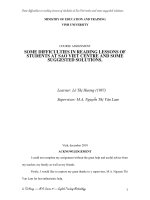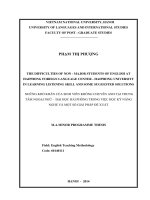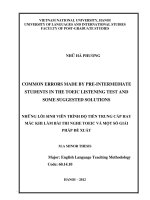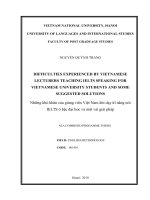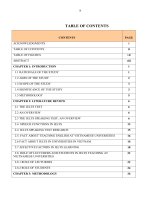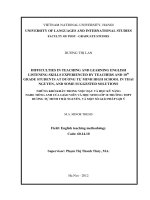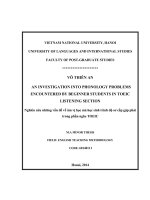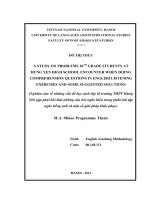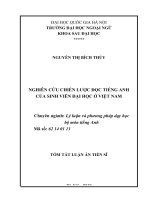Common mistakes made by pre-intermediate students in TOEIC listening tests and some suggested solutions = Những lỗi sinh viên trình độ tiền trung cấp hay mắc tr
Bạn đang xem bản rút gọn của tài liệu. Xem và tải ngay bản đầy đủ của tài liệu tại đây (5.23 MB, 76 trang )
1
VIETNAM NATIONAL UNIVERSITY, HANOI
UNIVERSITY OF LANGUAGES AND INTERNATIONAL STUDIES
FACULTY OF POST-GRADUATE STUDIES
NHỮ HÀ PHƯƠNG
COMMON ERRORS MADE BY PRE-INTERMEDIATE
STUDENTS IN THE TOEIC LISTENING TEST AND
SOME SUGGESTED SOLUTIONS
NHỮNG LỖI SINH VIÊN TRÌNH ĐỘ TIỀN TRUNG CẤP HAY
MẮC KHI LÀM BÀI THI NGHE TOEIC VÀ MỘT SỐ GIẢI
PHÁP ĐỀ XUẤT
M.A MINOR THESIS
HANOI – 2012
Major: English Language Teaching Methodology
Code: 60.14.10
ii
TABLE OF CONTENTS
Acknowledgements i
Abstract ii
List of figures, tables and appendices iii
List of abbreviations iv
PART A: INTRODUCTION 1
1. Statement of the problem and rationale for the study 1
2. Aims and objectives 2
3. Significance of the study 2
4. Scope of the study 2
5. Methods of the study 3
6. Organization 3
PART B: THEORETICAL BACKGROUND 4
1. Listening 4
1.1. Listening Definition 4
1. 2. Listening Comprehension 4
1. 3. Factors affecting learners’ listening comprehension 6
2. Error 11
2. 1. Error definition 11
2. 2. Classification of errors 12
2.3. Different approaches towards the study of error 13
3. The TOEIC test 14
3. 1. Overview of the TOEIC test 15
3. 2. Overview of the TOEIC listening test 16
4. Related studies of listening comprehension and TOEIC listening errors
20
PART C: METHODOLOGY 22
iii
1. Selection of subjects 22
2. Data collection instruments 22
2.1. Students’ listening test papers 22
2.2. Questionnaires 23
2.3. Semi-structured interviews 23
3. Research methods 24
4. Procedures of data analysis 24
PART D: RESULTS AND DISCUSSION 26
1. Findings from the Questionnaires and Interviews 26
1.1. General information of the participants 26
1.2. Learners’ perceptions of the TOEIC listening test 28
1.3. Learners’ perceptions of the causes of common errors when
listening TOEIC test 29
1.4. Test-taking strategies applied by students in TOEIC listening 33
2. Findings from the analysis of students’ TOEIC listening test papers 35
3. Recommendations 42
PART E: CONCLUSION 46
1. Conclusion 46
2. Limitations of the study 47
3. Suggestions for further study 48
REFERENCES
APPENDICES
iv
ACKNOWLEDGEMENTS
This research would not have been completed without support from a
number of people. My lecturers at University of Languages and International
Studies, Vietnam National University, friends and family have given me
support and have in one way or another contributed to the work present here.
First and foremost, I would like to heartily express my deepest
appreciation and gratitude to my supervisor, Ms. Phan Thi Van Quyen, M.A
who is always willing to work hard to give her expert guidance, knowledge,
insight and time. She followed the research from the initial stage giving
support and constructive criticism. I am very grateful and have learnt much
from her.
My particular thank goes to all students who were enthusiastic
participants in the study.
And I am immensely grateful to my friends who nonstop encourage
me to continue the research. Moreover, without the well of love and support
from my family this thesis would not have been as successful.
Nhu Ha Phuong
v
ABSTRACT
Phuong, N.H (2012): Common errors made by pre-intermediate
students in the TOEIC listening test and some suggested solutions. A
Master’s Thesis submitted to Vietnam National University, University of
Foreign Languages and International Studies.
In Vietnam nowadays or Haiphong’s institutions in particular, a new
standard for English proficiency is set, that is the requirement of TOEIC
certificate. Thus, many foreign language centers emphasize the development
of teaching and learning TOEIC. While efforts have been made, far less
attention is paid to the common errors made by students in TOEIC test. To
bridge the gap, this thesis aims to explore the errors made by pre-
intermediate students in the TOEIC listening test and to find out the
solutions regarding this issue. This work hopes to both contribute to the
existing body of TOEIC research as well as to pave the way for future
studies in this field.
vi
LIST OF FIGURE, TABLES & APPENDICES
Figure 1: Information sources in comprehension
Table 1: Factors influencing listening comprehension (Teng)
Table 2: Categories of barriers reported in learning the listening strategies
Table 3: Learners by age, gender and occupation
Table 4: Learners’ experience of learning English in years
Table 5: Learners’ purposes of taking TOEIC preparation course
Table 6: Learners’ evaluation of the level of difficulty of TOEIC listening
test
Table 7: Learners’ evaluation of the most difficult part of TOEIC listening
test
Table 8: Learners’ feelings when doing TOEIC listening test
Table 9: Causes of TOEIC listening errors
Table 10: Strategies used by learners when taking TOEIC listening test
Table 11: The percentage of wrong-answers in each TOEIC listening test
Table 12: Types of errors in TOEIC listening test and their percentage
Appendix 1: Questionnaire for student respondents
Appendix 2: TOEIC listening test sample and its tape script
vii
LIST OF ABBREVIATIONS
TOEIC: Test of English for International Communications
HFLC: Haiphong Foreign Language Centre
1
PART A: INTRODUCTION
This initial part states the problem and the rationale of the study,
together with the aims, objectives and the scope of the whole paper. Above
all, it is in this chapter that the research questions are identified to work as
clear guidelines for the whole research.
1. Statement of the problem and Rationale for the study:
Facts have shown that English proficiency tests such as the Test of
English for International Communication (TOEIC), the Test of English as a
Foreign Language (TOEFL), and the International English Language Test
System (IELTS) are currently enjoying a surge in popularity in both
workplace and universities, especially the TOEIC test. In other words, many
colleges and universities award credits in English courses to students who
reach test score requirements, and an increasing number of companies are
using these scores as one criterion for selecting new recruits and promoting
employees. Specifically, in Haiphong, the three biggest universities namely
Vimaru (Vietnam Marine time University), Haiphong University and HPU
(HaiPhong Private University) are forcing their students to have at least
TOEIC 450 as a crucial requirement to graduate. HPU also announced the
target score for Vietnamese English teachers as TOEIC over 700. Some
companies in the region like Vietnam register of shipping or Internal
Relations Office demand their employees to have TOEIC at least 380. Yet,
to many TOEIC students, listening is a nightmare and most failing in
TOEIC, TOEFL or even IELTS are generally weak at listening. Obviously,
achieving language proficiency means mastering the four skills and listening
is considered to be one of the most problematic.
2
Establishing reputation for being a reliable place providing and
training English courses for such a long time, Haiphong Foreign Language
Centre has attracted thousands of learners to register TOEIC courses since
they were first introduced in 2010. Identifying the demands of studying
TOEIC in Haiphong as well as the teaching situation, “Common errors
made by pre-intermediate students in the TOEIC listening test and some
suggested solutions” was conducted to gain insights into students’ problems
when listening TOEIC practice tests with the hope to contribute to the
improvement of TOEIC teaching in Haiphong Foreign Language Centre as
well as other educational institutions.
2. Objectives of the study:
The purpose of the study is to explore the following objectives:
To explore the students’ perceptions of the TOEIC listening test
To investigate the errors that pre-intermediate students at Haiphong
Foreign Language Center often make when taking the TOEIC
listening test
To suggest solutions to avoid errors based on the results of the study
The research questions, therefore, are addressed as below:
1. What are pre-intermediate students’ perceptions of the TOEIC
listening test?
2. What strategies do these students often apply when doing TOEIC
listening test?
3. What are the common errors when taking the TOEIC listening test
made by pre-intermediate students?
3. Significance of the study:
With the above objectives, the study primarily displays insightful
knowledge of errors conducted by pre-intermediate students as well as their
3
difficulties or strategies in listening TOEIC. Pedagogically, the findings of
the study are believed to be useful for both TOEIC teachers and learners.
4. Scope of the study:
The research focuses mainly on the analysis of the data collected from
the students’ TOEIC listening test papers and the survey questionnaire
distributed to TOEIC students at Haiphong Foreign Language Centre.
5. Methods of the study:
Both quantitative and qualitative approaches, including a survey
questionnaire, students’ TOEIC listening test papers and semi-structured
interviews, are employed to collect data for the study and the major method
used is the quantitative one. Firstly, the analysis of students’ TOEIC listening
test papers is conducted to find out the common errors as well as the current
situation of learning this skill. Then, the data is also collected through survey
questionnaire, informal interviews and discussions with these TOEIC
learners.
6. Organization:
Part A- Introduction describes the study’s rationale, aims, objectives,
research questions, scope, methods and significance.
Part B- Theoretical Background lays the theoretical foundation for the
research.
Part C- Methodology details the research methods that have been used
and the procedures of conducting the study.
Part D- Results and Discussion presents the research’s findings about
the errors of pre-intermediate students when listening TOEIC test and then
explains the causes of these errors. This explanation will lead to some
possible implications behind the findings.
4
Part E- Conclusions ends the study by summarizing its main points,
implications, limitations and suggestions for further studies.
Moreover, the thesis includes Appendices where the study’s
bibliography, sample questionnaires and interview transcription are attached
for reference.
5
PART B: THEORETICAL BACKGROUND
This part attempts to provide the framework within which the research is
carried out.
1. Listening
1.1. Listening
There are different definitions about listening coming from different
views of the linguists. It is believed that listening is a significant and
essential element of communication and interaction in a native language and
in second language as well. Rost (2002, p. 279) defines listening as “mental
process of constructing meaning from spoken input”. Similarly, Helgesen
(2003, p.24) proposes “listening is an active, purposeful processing of
making sense of what we hear”. From these definitions, it is clear that the
listener is doing more than simply decoding what is heard.
In fact, a person who is trying to learn a second or foreign language
has to improve four basic language skills possessed by the native speakers of
that language. As stated by Harmer (1998), speaking and writing, which
involve language production, are referred to as productive skills. Listening
and reading, on the other hand, involve receiving messages and therefore,
they are identified as receptive skills.
Listening skill is a receptive skill in which listeners actively produce
comprehension. There is a purpose behind every listening people perform.
However, in a conversation listeners should also consider other factors apart
from sound. Listeners do not only receive the auditory stimuli but also visual
stimuli, for example face expression, posture, movement, appearance and so
on. For example, in the TOEIC listening Part 1, visual stimuli (in the form of
photographs) is used.
1.2. Listening Comprehension
6
When listening is referred to during discourse, it tends to be connected
automatically to comprehension. This is due to the fact that “comprehension
is often considered to be the first-order goal of listening, the highest priority
of the listener, and sometimes the sole purpose of listening.” (Rost, 2002).
Especially for the L2 learners who are acquiring a new language, the term
“listening comprehension” typically refers to all aspects of listening since
comprehension through listening is considered to be a foundation for
enabling learners to process the new language, and since L2 listening
research has focused exclusively on the comprehensive aspect of academic
listening. However, Rost (2002) insisted that the term “comprehension”
needs to be used in a more specific sense in listening studies.
Buck, G. (2001: 31) shares the idea that "listening comprehension is
an active process of constructing meaning and this is done by applying
knowledge to the incoming sounds" in which "number of different types of
knowledge are involved: both linguistic knowledge and non-linguistic
knowledge". Thus, the development of good listening skill is suggested to be
valuable for its own sake and support the growth of other aspects of
language use, such as reading and speaking.
Listening comprehension is influenced by the listener’s world
knowledge, linguistic knowledge, text structure knowledge, and met
cognitive knowledge. The following figure shows that the listening
comprehension process is established through the relationship between the
two main sources of information; namely: systematic or linguistic
knowledge (knowledge of phonological, syntactic, and semantic components
of the language system) and schematic or non-linguistic information. In fact,
it is hard to differentiate between what was actually said and what we have
constructed by integrating the spoken words with students' own knowledge
and experience.
7
Background knowledge
Systematic
knowledge
- factual
- social
Procedural knowledge
- how language is used in
discourse
Knowledge of situation
- physical setting, participants,
etc
Knowledge of co-text
context
- what has been/ will be said
(written)
Knowledge of the language
system
- semantic
- syntactic
systematic
knowledge
- phonological
Figure 1. Information sources in comprehension
(Anne Anderson & Tony Lynch, 1988, p.13)
Like reading comprehension, listening comprehension involves two
stages: (1) apprehending linguistic information (text-based: low level) and
(2) relating that information to a wider communities context ( knowledge-
based: high level) and there are two processing models for comprehension:
(1) bottom-up and (2) top down.
1.3. Factors affecting learners’ listening comprehension
Of the five main lines of research on listening summarized by Dunkel
(1991: 434), the following two have some bearing on the listening
difficulties that learners experience while listening, namely: 1) Research on
C
O
M
P
R
E
H
E
N
S
I
O
N
8
the components (sub-skills) of listening involved in SL listening and 2)
Research on the factors inside and outside the head that enhance or inhibit
the comprehension of input in the SL.
As the listening is a complicated active process in which learners
decode and construct the meaning of the text by drawing on their previous
knowledge about the world as well as their linguistic knowledge, there
seems to be many factors affecting listening comprehension and these
factors have been classified into different categories. Boyle (1984), after
conducting an interview with thirty teachers and sixty students from two
Hong Kong University suggested lack of practice as the most important
factors. He also pointed out such factors as linguistic understanding, general
background knowledge, while attitude and motivation may affect listening
directly but more powerfully. Two other factors that were mentioned by the
students but not teachers in Boyle’ interview were “memory” and
“attention/concentration”. In general, these factors can be divided into four
categories, i.e., listener factors, speaker factors, stimulus factors, and context
factors. In her study Teng (1993) further divided these factors into a list as
presented in the Table 1.
A. Listener factor
1. Language facility, including phonological, lexical, syntactic, semantic, pragmatic
knowledge
2. Knowledge of the world
3. Intelligence
4. Physical condition
5. Metacognitive strategies
6. Motivation
B. Speaker factors
1. Language ability: native speaker vs. nonnative speaker
9
2. Accent/dialect
3. Speech of delivery
4. Degree of pauses and redundancies
5. Prestige and personality
C. Stimulus factors
1. Discussion topic
2. Abstractness of material
3. Vagueness of word
4. Presentation mode; audio only vs. audio and visual
5. Acoustic environment
D. Context factors
1. Type of international event
2. Distraction during listening
3. Interval between listening and testing
4. Note-taking
Table 1: Factors influencing Listening Comprehension Teng (1993)
Listener factors
The factors characterize listeners are the language facility, knowledge
of the world, intelligence, physical conditions, metacognitve strategies and
motivation. (Boyle)
The language facility requires the learners have the knowledge of the
phonological, lexical, syntactic, semantics and pragmatics which are not
easy for the learners especially the low level learners and the non major
ones.
One of the most important factors which have influence directly on
the listeners’ ability is the physical conditions which should be free from
illness, and able to function efficiently and effectively, to enjoy leisure, and
to cope with emergencies. Health-related components of physical fitness
include body composition, cardiovascular fitness, flexibility, muscular
10
endurance, and muscle strength. Skill-related components include agility,
balance, coordination, power, reaction time, and speed. Therefore it is
advisable for the teachers to pay more attention to the learner’s health.
Interest in a topic increases the listener’s comprehension; the listener
may tune out topics that are not of interest. This can create the motivation
for the listeners to listen well and study better.
Speaker factors.
During listening process, learners sometimes have difficulty to
distinguish different voices of the speaker as well as the speech.
It appears to be easier for the students to listen to their non-native than
native teachers or the listening materials. Being not used to the speech of
delivery or the accent/ dialect also causes the some learners difficulty and
leads them to understand nothing as they cannot catch the main information
hidden in the key words.
Stimulus factors
These factors are suggested to play an important role in creating the
enthusiasms and motivation for the listeners to improve the listening ability.
The familiarity of the topic helps students feel safe and confident and they
feel comfortable when dong the listening task. This is a useful tip for teacher
teaching listening skills. On the contrary, the abstractness of the material
causes quite great deal of difficulties for listeners, in other words, they do
not know what to do and get lost and left behind. Moreover the numbers of
the words especially the new words also headache the learners. Furthermore,
the condition- acoustic environment and the mode of the listening task also
give favors to the learners. If they are put in high technology environment
along with the visual material, they can analyze the task and complete them
quite eagerly.
11
Context factors.
The concentration is always the best way to study any skills of a
foreign language, particularly the listening which is considered as a complex
process. That is the reason why the distraction affects the listening ability so
much, the distraction here can the class noise, street noise, background noise
of the acoustic materials. Furthermore, the note taking technique is also a
key factor to study listening skill well. The listeners can save time and effort
if they know how to process the input effectively.
Rixon (1986, 37) identifies two problems arising in listening
comprehension, one stems from pronunciation and the other stems from
passage or discourse. Some examples of listening problem stemming from
pronunciation are weak relationship between sounds and the way they are
spelt in written language, change in sounds where they occur in rapid and
connected speech, the rhythm patterns of English speech, and different ways
of pronouncing the same sounds. These problems only appeared when
students deal with listening tasks. The next problem stemming from passage/
discourse may include type of delivery (the speech of utterance, clarity,
processing time and accent) and numbers of speakers.
Another researcher from Taiwan, Chen (2005) conducts a listening
obstacles research with Chinese native speakers, those who language has
quite many similar things to Vietnamese. Seven major categories of learning
obstacles were derived, including 22 minor groups as follows:
Barrier category 1: Affective barriers
Barrier category 2: Habitudinal barriers
Barrier category 3: Information processing barriers
Type 1: Obstacles pertaining to spoken-word recognition
Type 2: Obstacles pertaining to processing speed
12
Type 3: Obstacles pertaining to input retention
Type 4: Obstacles pertaining to processing distraction
Type 5: Obstacles pertaining to interpretation
Type 6: Obstacles pertaining to fatigue
Barrier category 4: English proficiency barriers
Type 1: Obstacles pertaining to limited English vocabulary
Type 2: Obstacles pertaining to poor grammar
Type 3: Obstacles pertaining to overall English proficiency
Barrier category 5: Strategic barriers
Type 1: Forgetting to activate strategies while listening
Type 2: Regarding strategies as extra burdens to information
processing
Type 3: Challenged by the complex nature of the strategy
Type 4: Having problems conducting the proper strategies
Type 5: Still unable to comprehend the text after applying strategies
Barrier category 6: Belief barriers
Type 1: Applying strategies after other language skills were acquired
Type 2: Attending to every word or demanding full comprehension of
text
Barrier category 7: Material barriers
Type 1: Obstacles pertaining to difficulty level of materials
Type 2: Obstacles pertaining to spoken features
Type 3: Obstacles pertaining to length of sentences or texts
Type 4: Obstacles pertaining to text genre
Type 5: Obstacles pertaining to topics
Type 6: Obstacles pertaining to modalities
Table 2: Categories of barriers reported in learning the listening
strategies
2. Error
2.1. Error definition:
Defining errors in foreign language teaching is still a controversial
issue because it is not seen in the same way by different error analysts.
13
Therefore, to have a comprehensive view of errors made by second language
learners, we should review different ways of defining errors by different
researchers. Through the development of error analysis, some analysts have
defined errors directly. Some defined “errors” as a deviation from the norm
of the target language. A noticeable representative of this view is Corder
(1973, p89), who considered “error” as the “breaches of codes”. However,
this definition is not very clear because the definition of “norm” itself is still
ambiguous. One language has a number of variants and dialects, which
means that what is considered erroneous in one region may be acceptable in
others. Therefore, if we define “error” in this way, we should identify a very
specific basis on which something is considered erroneous.
Besides, there are many other terms which are easily mistaken with
“error”, especially the term “mistake”. Therefore, many analysts defined
“error” through the distinction between “error” and “mistake”. Corder
(1967, p25) says that it will be useful to refer to error of performance as
“mistakes” which is not significant to the language learning process , and
reserve the term “error” for the systematic errors of the learner from which
his knowledge of the language can be reconstructed.
Snow (1977) had a different view of distinguish between “error” and
“mistake” which is based on learners’ conscious of doing something wrong.
According to him, there are three stages that second language learners have
to experience in learning language. The first stage is when learner does
something wrong without knowing it, in the second stage, he does know that
it is wrong but he does not know how to put it right and the last stage is
when he can correct his wrong version. For him, error occurs at the first two
stages while mistake belongs to the last stage.
14
From the linguists’ opinion above, it can be concluded that a mistake
refers to a performance error that is either a random guess or a “slip”, in that
it is a failure to utilize a known system correctly. Mistakes are what
researchers have referred to as “performance errors” while errors are a
result of one’s systematic competence (the learner’s system is correct).
2.2. Classification of errors
When dealing with students’ errors, it is better if they are put in
different categories for various treatments. Therefore, we should have an
overview of different ways of classifying errors so far. As a matter of fact,
different researchers have different purposes of studying errors as well as
different criteria for categorizing errors. Therefore, to reach a common
classification of listening errors seems to be infeasible. Even for the same
author, his way of classifying errors can change over time. As it would be
impossible to list all the ways of classifying errors, therefore, in this thesis,
the author just wants to mention some typical and common ones of some
well-known authors.
Based on the magnitude of errors, which includes errors at different
levels such as a phoneme, morpheme, word, sentence or paragraph, Richards
(1984, p123) divides errors into two kinds: global errors and local errors.
According to him, “global errors” are those which involve the “overall
structure of the sentence”. Therefore, it can hinder the communication and
prevent the message from being understood. On the contrary, local errors are
those which affect “a particular constituent” of the sentence and they do not
prevent the message from being comprehended because the hearer can still
guess the intended meaning easily.
In order to identify the source of errors, James (1998) distinguishes
four categories of errors: 1. Interlingual errors: when the required target
15
language item is unknown and the learner borrows a first language
substitute. As a result, they can make a mother tongue transfer error (p.175)
2. Intralingual errors: Errors include false analogy (e.g. boy and boys vs.
child and Childs), misanalysis, incomplete rule application (under
generalization), exploiting redundancy, overlooking co-occurrence
restrictions, hypercorrection and overgeneralization (pp.185-187) 3.
Communication-strategy errors: Errors include the use of holistic strategies
(e.g. Students do not find the required form, so they try to use another near-
equivalent second language item which they have learnt) and analytic
strategies (expressing the concept indirectly, by allusion rather than by direct
reference, also called circumlocution) (p187-188). 4. Induced errors: Errors
include materials-induced error, teacher-talk induced error, exercise-based
induced errors, errors induced by pedagogical priorities, look-up errors
(p191-200)
2.3. Different approaches towards the study of error
There are various approaches towards the study of error. In general,
they belong to either Linguistic Approaches or Non- Linguistic Approaches.
The Linguistic Approaches include : (i) Contrastive Analysis Approach (ii)
Error Analysis Approach while the Non-Linguistic Approaches include: (i)
Sociological Approach (ii) Psychological Approach. In the scope of this
study, only Linguistic Approaches are closely considered.
Contrastive Analysis Approach borrowed principles from the field of
psychology of learning such as imitation, reinforcement, habit strength and
positive and negative transfer. This approach presupposed that language
development consists of the acquisition of a set of habits, so errors in the
second language were regarded as the result of the first language habits
interfering during the acquisition of the habits of a second language. Thus,
16
special attention should be paid to the differences between the mother
tongue and the second language. However, this approach provides an
incomplete presentation of the second-language acquisition process and it
gradually became unpopular because of some obvious shortcomings. Firstly,
it overemphasizes the interference of the outer environment of language
study while the language learners themselves are totally neglected.
Secondly, the fact shows that most of learners’ errors are not predictable on
the basis of contrastive analysis. For examples, some types of errors like rule
simplification and overgeneralization which show a striking resemblance to
errors made by children while acquiring a first language, could not be
accounted for by contrastive analysis.
Error Analysis Approach is considered more reliable than the
Contrastive Analysis Approach. This approach adopts the view that the
sources of linguistic interference are not restricted to the learners’ mother
tongue. Many analysts of this approach has pointed out that there are some
similarities between the types of errors made by second language learners
and those made by native speakers in their first language acquisition .
Therefore, the process of acquiring the first and second language are
essentially the same (Corder 1967, Dulay and Burt 1972, Richards 1973).
This approach aims at describing the nature of the interlanguage in its stages
of development through the evidence in errors, from which the process of
second language acquisition can be inferred. Between these two linguistic
approaches, the writer prefers the Error Analysis Approach because it
reflects truthfully the nature learning a foreign language as well as the nature
of errors which are not only caused by the interference of the mother tongue
but by other intralingual factors as well.
3. The TOEIC test
17
3.1. Overview of the TOEIC test
The Test of English for International Communication (TOEIC), which
was developed by Educational Testing Service (ETS) in Japan in 1979, is
defined as “a standardized test that measures your listening and reading
skills. Unlike other tests, the TOEIC evaluates your ability to function in the
business world rather than in an academic setting”. For this reason, TOEIC
has become the preferred exam for corporations, government agencies and
many educational institutions to test learners’ English capabilities. Many do
the TOEIC with the hope to measure their improvements in English, others
need to meet the demands of school or work.
Traditionally and popularly, TOEIC is a paper-and-pencil test
consisting two sections: listening and reading comprehension. There are 100
multiple-choice questions in each section. Separate scaled scores are
provided for each section, the part score scales ranging from 5 to 495 and
the total score scales ranging from 10 to 990. The TOEIC test provides a
good indication of candidates' abilities in English.
These are some examples of the topics examiners may find in TOEIC
test questions, according to “TOEIC Examinees Handbook- Listening &
Reading” (2008: 3)
Corporate Development — research, product development
Dining Out — business lunches, banquets, receptions, reservations
Entertainment — cinema, theater, music, art, exhibitions, museums,
media
Finance and Budgeting — banking, investments, taxes, accounting,
billing
General Business — contracts, negotiations, mergers, marketing,
sales, …
18
Health Care — medical insurance, visits to doctors, dentists, …
Housing/Corporate Property — construction, specifications, buying
and renting, electric and gas services
Human Resources — recruiting, hiring, retiring, promoting, job
applications, job advertisements, salaries, pensions, awards………
Manufacturing — assembly lines, plant management, quality control
The Office — procedures, board meetings, committees, letters,
memos, telephone, fax and e-mail messages, equipment
Purchasing — shopping, ordering supplies, shipping, invoicing
Technical Areas — electronics, technology, computers, laboratories
and related equipment, technical specifications
Travel — trains, airplanes, taxis, buses, ships, ferries, tickets,
schedules, station and airport announcements, car rentals, hotels,
reservations,
3.2.
Overview of the TOEIC listening test
Needless to say, TOEIC listening is a kind of listening
comprehension.
The TOEIC listening test includes 100 questions with a time
limit of 45 minutes. It is divided into 4 sections, namely: picture description
(10 questions), question-response (30 questions), short conversations (30
questions), and short talks (30 questions). Thus, each section has different
stimulus material. The listeners’s ability to understand what they hear and
then choose the correct answer is being evaluated. It might be a detail to
remember, an inference to make, or main idea that they need to comprehend.
All the questions will have topics or situations that you would likely
encounter on a regular basis in a business environment.
Part one: Pictures description (10 questions)
